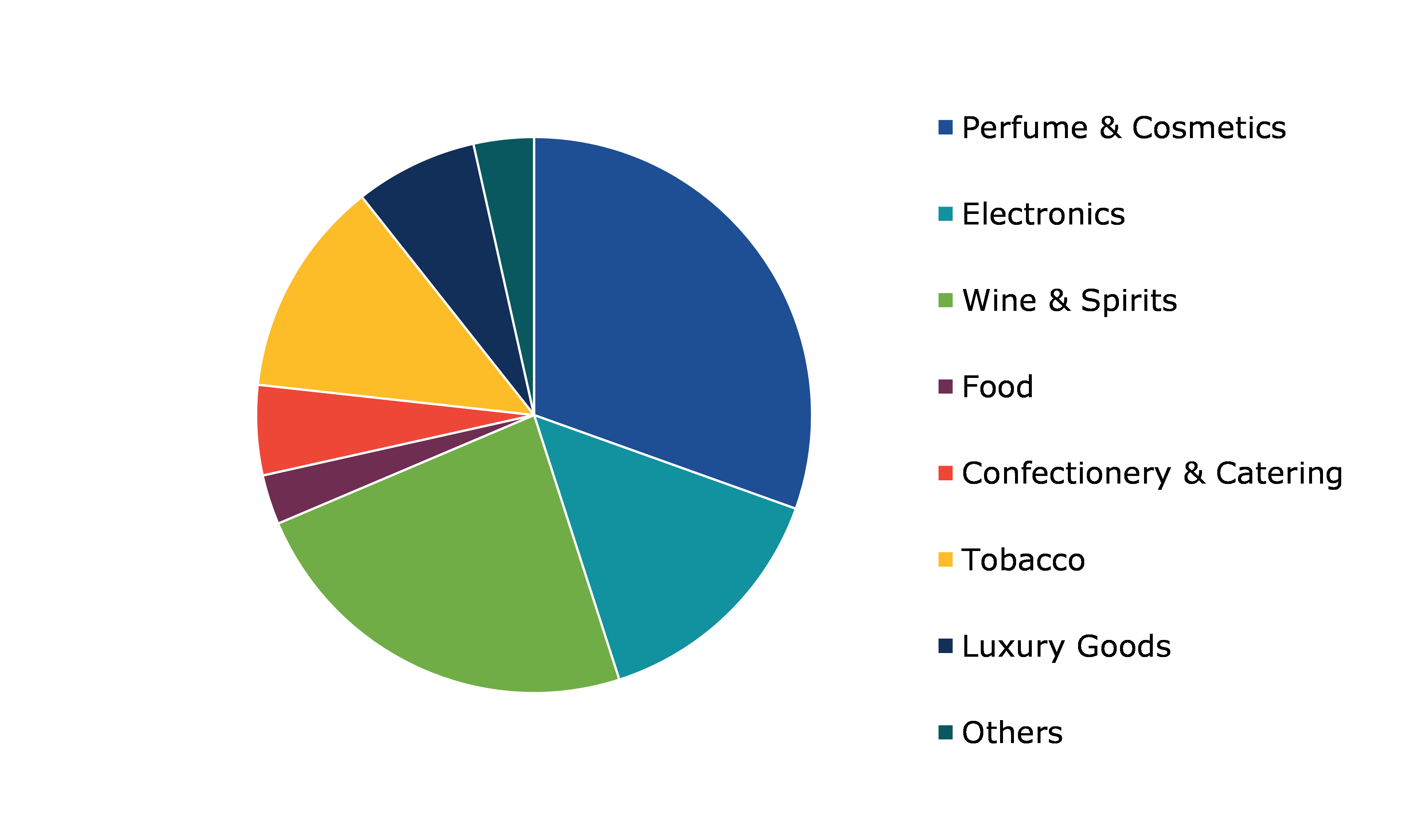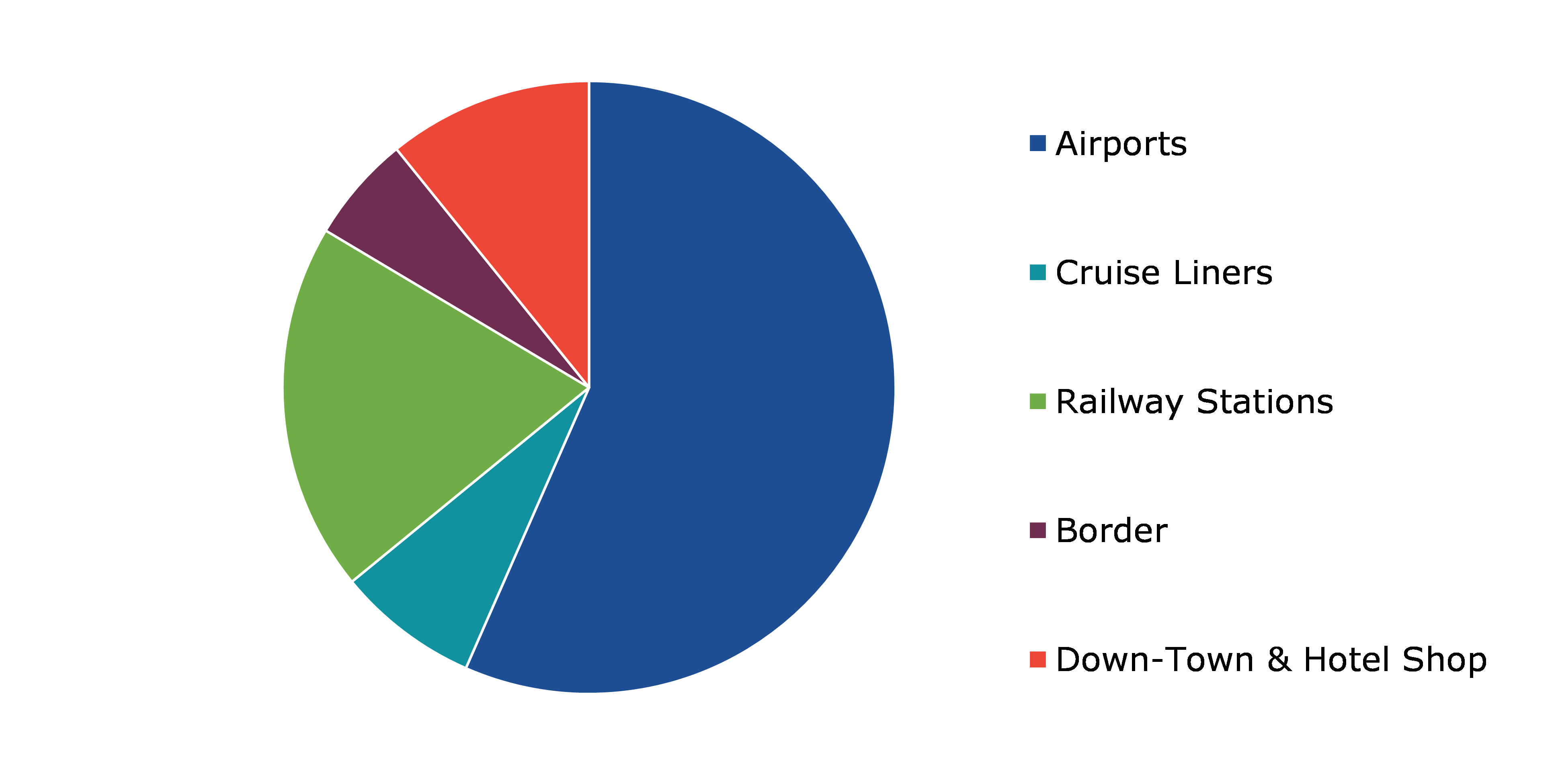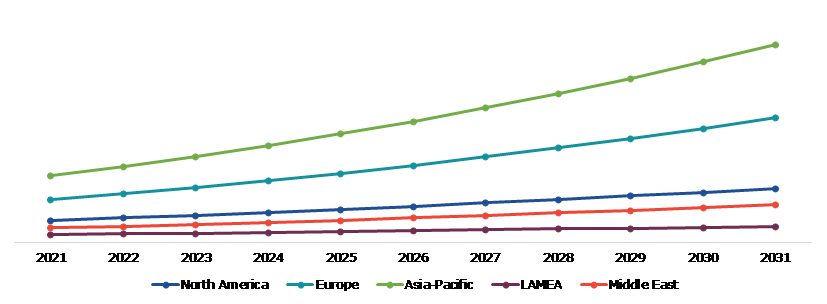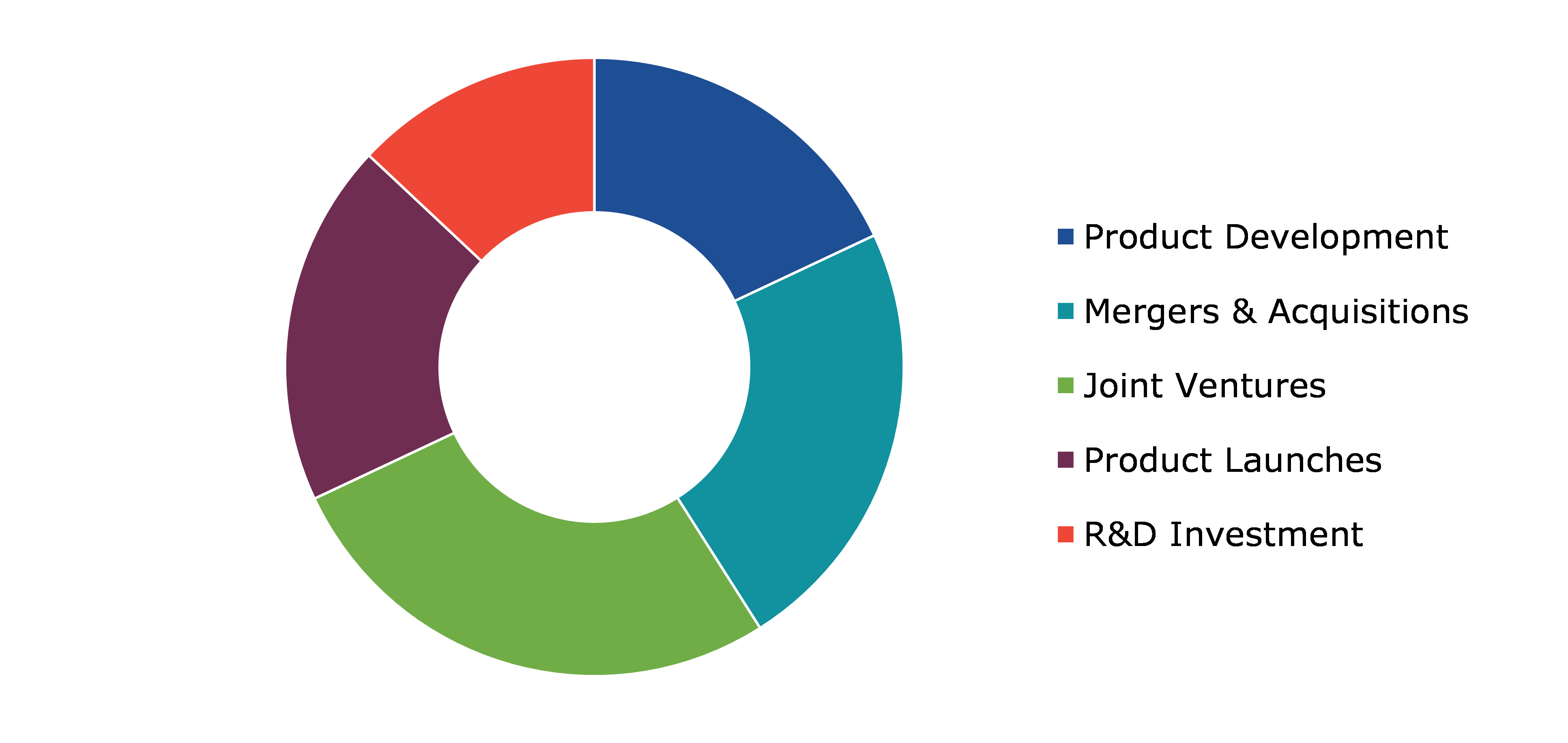Duty-Free Retailing Market Report
RA00155
Duty-Free Retailing Market by Product Type (Perfume & Cosmetics, Electronics, Wine & Spirits, Food, Confectionery & Catering, Tobacco, Luxury Goods, and Others), Sales Channel (Airports, Cruise Liners, Railway Stations, Border, and Down-Town & Hotel Shop), and Regional Analysis (North America, Europe, Asia-Pacific, and LAMEA): Global Opportunity Analysis and Industry Forecast, 2022–2031
Global Duty-Free Retailing Analysis
The global duty-free retailing market size was $33,651.8 million in 2021 and is predicted to grow with a CAGR of 10.6%, by generating a revenue of $94,203.7 million by 2031.
Global Duty-Free Retailing Market Synopsis
An increase in the number of passengers globally across airports, ferry terminals, and airlines is estimated to boost the duty-free retailing market growth. Increase in the use of technology at airport terminals for the check-in and boarding process has provided duty-free retailers with the convenience to attract and engage passengers for delivering a convenient shopping experience. These factors are estimated to boost the duty-free retailing market share during the forecast period.
The lack of stores other than those found at airports or on ships is a major impediment to duty-free retailing market growth. There are a few retail outlets outside of major transit hubs such as airports, railway stations, and ship ports, but they are insufficient for local customers to conveniently get merchandise. The duty-free retailing industry is only exposed to a limited number of clients since they are limited to specific locations, which is predicted to limit market growth to some extent.
Several developing countries are investing in new airport construction or development activities to meet rising passenger demand. An increase in disposable income of middle-class families in emerging countries, as well as the expansion of downtown duty-free stores is estimated to have a positive impact on the duty-free retailing market outlook during the forecast period.
According to regional analysis, the Asia-Pacific duty-free retailing market is anticipated to show the fastest growth during the projected timeframe. The Asia-Pacific region is expected to increase due to rising disposable income and a rising middle-class population. Furthermore, the presence of a significant number of global companies in the retail sector is expected to drive the region's industry growth throughout the projection period.
Duty-Free Retailing Market Overview
Duty-free retailing is a highly controlled retail environment that is mostly found at international airports and ship terminals. Free retail stores offer duty-free items that fall under different jurisdictions and laws based on the calculation, allowable restrictions, and a variety of other variables. The duty-free retailing market contributes significantly to the worldwide travel and tourist and aviation industries. The duty-free retailing market is regarded as one of the most important sources of non-aeronautical income. A typical individual cannot enter these businesses; the person must have travel documentation to enter the commercial sector.
COVID-19 Impact on Global Duty-Free Retailing
The duty-free retailing industry has been severely impacted during the COVID-19 pandemic. This is because the trade body of Airport Council International has anticipated that air passenger traffic has declined by almost 40 percent in 2020. Air terminals have lost more than 88% of their travelers to date and most of the airport stores are being forced to shut down and only a few are operational that are letting the customers pass through. The unprecedented COVID-19 outbreak had a major impact on the duty-free & travel retail (DF&TR) industry. DF&TR is depending on passenger transport capacity being revived, which will very definitely take some time. Furthermore, travelers must be confident that they can travel securely again. Post-pandemic, the duty-free retailing business is expected to revive at a faster rate as the lockdowns are normalized. Improved focus on the health and well-being of passengers will be a megatrend that boost the duty-free retailing market trend post-pandemic.
Rapid Expansion of the Tourism Industry is Estimated to Boost the Market Expansion
The number of inbound and outgoing travelers is increasing significantly owing to rise in the number of airports visitors globally. An increase in domestic as well as international business travels and, sports travel is a significant factor propelling the duty-free retailing market size. Summer Olympic games, UEFA Euro, UEFA Champions League, and Premier Leagues are some of the major events that attract huge numbers of travelers across the globe. Every year, sports events are organized in various countries throughout the world, increasing the number of international tourists and visitors, which stimulates retail sales of luxury and branded items, notably through duty-free establishments. All the major European countries, as well as the Asia-Pacific countries namely Malaysia, Singapore, Japan, and Thailand, attract a large number of visitors across the globe, thereby driving the duty-free retailing market sales.
To know more about global duty-free retailing market drivers, get in touch with our analysts here.
Stringent Regulations on the Sale of Duty-Free Tobacco Products to Restrain the Market Growth
Several countries across the world have imposed stringent regulations on the sale of tobacco goods such as cigarettes at duty-free retailing stores in past years. This is majorly owing to an increase in the number of patients suffering from fatal diseases such as different types of cancers. Also, another factor affecting duty-free cigarette sales is the absence of popular overseas brands such as Benson & Hedges and Lambert and Butler at various stores.
An Increase in Number of Duty-Free Retailing Stores with Technology Integration is Estimated to Boost the Market Growth
There has been a rapid shift in consumer shopping behavior from offline to online stores due to the COVID-19 pandemic. Owing to the same, major vendors in the global duty-free retailing business, such as Dufry AG, Delhi Duty-Free, and Dubai Duty-Free, have built websites to give their clients a hassle-free shopping experience with various promotional codes and discounts that will help in attracting a large number of users. Also, technology integration has facilitated the tracking of human behavior both online and physically with advanced analytics and greater personalization. An increase in contactless shopping experiences with a major focus on zero-waste production and sustainable consumption practices in the e-commerce travel retail sector is anticipated to generate excellent opportunities in the market.
To know more about global duty-free retailing market opportunities, get in touch with our analysts here.
Global Duty-Free Retailing Market, by Product Type
Based on product type, the market has been divided perfume & cosmetics, electronics, wine & spirits, food, confectionery & catering, tobacco, luxury goods, and others. Among these, the perfume & cosmetics sub-segment accounted for the highest market share in 2021, and it is estimated to show the fastest growth during the forecast period.
Global Duty-Free Retailing Market Share, by Product Type, 2021
Source: Research Dive Analysis
The perfume & cosmetics sub-segment has accounted for the highest revenue share in 2021 and it is estimated to show the fastest growth in the upcoming years. This is majorly owing to the growing demand for personal care products such as skincare, fragrances, and cosmetics. The duty-free retail stores at main airports contain a range of collections and brands under one roof, making it easy for shoppers to buy the items. Due to their strong customer-centric strategies, branded cosmetics and perfume enterprises attract a large client base. Retailers also provide huge discounts and special offers on branded perfume brands namely Estée Lauder, MAC, Chanel, and others. These factors are projected to boost the perfume and cosmetics sub-segment growth during the analysis timeframe.
The wine & spirits sub-segment is expected to grow at a significant pace during the analysis timeframe. Duty-free shops have become a popular destination for visitors who enjoy shopping wines & spirits. This is majorly owing to the cost-effectiveness offered by duty-free retail stores for purchasing wine & spirits. This is due to the elimination of import tax by government bodies. Duty-free retailing stores have some of the finest collections of liquors namely Glenlivet, Pepe Lopez, Smirnoff, Ballantine’s, Johnnie Walker, and others. Also, at some airports namely Mumbai Dutyfree, customers can pre-order duty-free products from a wide range of international and premium wine & spirits brands.
Global Duty-Free Retailing Market, by Sales Channel
Based on sales channel, the market has been divided into airports, cruise liners, railway stations, border, down-town & hotel shop. Among these, the airports sub-segment accounted for highest revenue share in 2021 and it is estimated to show the fastest growth during the forecast period.
Global Duty-Free Retailing Market Analysis, by Sales Channel, 2021
Source: Research Dive Analysis
The airports sub-segment has accounted for a dominant market share in 2021. Airports are vital revenue generators for the travel retail business. This is majorly owing to the provision of duty-free retail goods such as perfumes & cosmetics, luxury goods, food, confectionery & catering, electronics, and others. As per the estimates, more than 1 billion passengers travel globally which is expected to boost the airport duty-free travel retail business. Shopping has interestingly become a crucial reason for travel and travelers on vacation exhibit different shopping behavior which is more inclined towards shopping of non-essential goods. Airports have become the pioneer places for various duty-free retailers to create brand awareness and influence consumer shopping habits.
Global Duty-Free Retailing Market, Regional Insights
The duty-free retailing market was investigated across North America, Europe, Asia-Pacific, and LAMEA.
Global Duty-Free Retailing Market Size & Forecast, by Region, 2021-2031 (USD Million)
Source: Research Dive Analysis
The Market for Duty-Free Retailing in Asia-Pacific to Show the Fastest Growth During the Forecast Period
The Asia-Pacific duty-free retailing market accounted for the highest revenue share in 2021 and it is predicted to show the fastest growth during the forecast period. Rapid developments in the travel & tourism sector as well as the upsurge in the number of travelers is estimated to boost the market growth. Additionally, the increase in urbanization, development of smart cities, mega-cities, and low-cost carrier aircraft is estimated to fuel the industry expansion. The introduction and expansion of duty-free outlets at international airports and seaports is also driving industry growth. The rising popularity of luxury & premium products at the airports, increase in digitization to enhance the consumer shopping habits is estimated to boost the duty-free retailing market size in the upcoming years. The penetration of social media, advertising & marketing tactics adopted by the duty-free retailers, and availability of duty-free items on e-commerce platform is fueling the industry growth.
Competitive Scenario in the Global Duty-Free Retailing Market
Business expansion and partnership are the major strategies adopted by the global duty-free retailing industry players. For instance, KING POWER International is a duty-free retailing firm established in Thailand. For instance, in April 2022, it was reported that a new duty-free store will be presented at Suvarnabhumi Airport in Thailand. This strategic step demonstrates the company's intention to create a dominant foothold in the duty-free market.
Source: Research Dive Analysis
Some of the leading duty-free retailing market players are Duty Free Americas, Inc, Shinsegae DF Inc., Aer Rianta International, Dubai Duty Free, China Duty Free Group Co Ltd., Lotte Hotels & Resorts, Dufry AG, Hyundai Department Store Duty Free, Lagardère Group, and LVMH.
| Aspect | Particulars |
| Historical Market Estimations | 2020 |
| Base Year for Market Estimation | 2021 |
| Forecast Timeline for Market Projection | 2022-2031 |
| Geographical Scope | North America, Europe, Asia-Pacific, and LAMEA |
| Segmentation by Product |
|
| Segmentation by Sales Channel |
|
| Key Companies Profiled |
|
Q1. What is the size of the global duty-free retailing market?
A. The size of the global duty-free retailing market was over $33,651.8 million in 2021 and is projected to reach $94,203.7 million by 2031.
Q2. Which are the major companies in the duty-free retailing market?
A. Duty Free Americas, Inc, Shinsegae DF Inc., Aer Rianta International, and Dubai Duty Free are some of the key players in the global duty-free retailing market.
Q3. Which region, among others, possesses greater investment opportunities in the near future?
A. The Asia-Pacific region possesses great investment opportunities for investors to witness the most promising growth in the future.
Q4. What will be the growth rate of the Asia-Pacific duty-free retailing market?
A. Asia-Pacific duty-free retailing market is anticipated to grow at 11.2% CAGR during the forecast period.
Q5. What are the strategies opted by the leading players in this market?
A. Business expansion and partnership are the two key strategies opted by the operating companies in this market.
Q6. Which companies are investing more on R&D practices?
A. China Duty Free Group Co Ltd., Lotte Hotels & Resorts, and Dufry AG are the companies investing more on R&D activities for developing new products and technologies.
1.Research Methodology
1.1.Desk Research
1.2.Real time insights and validation
1.3.Forecast model
1.4.Assumptions and forecast parameters
1.5.Market size estimation
1.5.1.Top-down approach
1.5.2.Bottom-up approach
2.Report Scope
2.1.Market definition
2.2.Key objectives of the study
2.3.Report overview
2.4.Market segmentation
2.5.Overview of the impact of COVID-19 on Global Duty-Free Retailing market
3.Executive Summary
4.Market Overview
4.1.Introduction
4.2.Growth impact forces
4.2.1.Drivers
4.2.2.Restraints
4.2.3.Opportunities
4.3.Market value chain analysis
4.3.1.List of raw material suppliers
4.3.2.List of manufacturers
4.3.3.List of distributors
4.4.Innovation & sustainability matrices
4.4.1.Technology matrix
4.4.2.Regulatory matrix
4.5.Porter’s five forces analysis
4.5.1.Bargaining power of suppliers
4.5.2.Bargaining power of consumers
4.5.3.Threat of substitutes
4.5.4.Threat of new entrants
4.5.5.Competitive rivalry intensity
4.6.PESTLE analysis
4.6.1.Political
4.6.2.Economical
4.6.3.Social
4.6.4.Technological
4.6.5.Environmental
4.7.Impact of COVID-19 on Duty-Free Retailing Market
4.7.1.Pre-covid market scenario
4.7.2.Post-covid market scenario
5.Duty-Free Retailing Market Analysis, by Product Type
5.1.Overview
5.2.Perfume & Cosmetics
5.2.1.Definition, key trends, growth factors, and opportunities
5.2.2.Market size analysis, by region,2021-2031
5.2.3.Market share analysis, by country,2021-2031
5.3.Electronics
5.3.1.Definition, key trends, growth factors, and opportunities
5.3.2.Market size analysis, by region,2021-2031
5.3.3.Market share analysis, by country,2021-2031
5.4.Wine & Spirits
5.4.1.Definition, key trends, growth factors, and opportunities
5.4.2.Market size analysis, by region,2021-2031
5.4.3.Market share analysis, by country,2021-2031
5.5.Food
5.5.1.Definition, key trends, growth factors, and opportunities
5.5.2.Market size analysis, by region,2021-2031
5.5.3.Market share analysis, by country,2021-2031
5.6.Confectionery & Catering
5.6.1.Definition, key trends, growth factors, and opportunities
5.6.2.Market size analysis, by region,2021-2031
5.6.3.Market share analysis, by country,2021-2031
5.7.Tobacco
5.7.1.Definition, key trends, growth factors, and opportunities
5.7.2.Market size analysis, by region,2021-2031
5.7.3.Market share analysis, by country,2021-2031
5.8.Luxury Goods
5.8.1.Definition, key trends, growth factors, and opportunities
5.8.2.Market size analysis, by region,2021-2031
5.8.3.Market share analysis, by country,2021-2031
5.9. Others
5.9.1.Definition, key trends, growth factors, and opportunities
5.9.2.Market size analysis, by region,2021-2031
5.9.3.Market share analysis, by country,2021-2031
5.10.Research Dive Exclusive Insights
5.10.1.Market attractiveness
5.10.2.Competition heatmap
6.Duty-Free Retailing Market Analysis, by Sales Channel
6.1.Airports
6.1.1.Definition, key trends, growth factors, and opportunities
6.1.2.Market size analysis, by region,2021-2031
6.1.3.Market share analysis, by country,2021-2031
6.2.Cruise Liners
6.2.1.Definition, key trends, growth factors, and opportunities
6.2.2.Market size analysis, by region,2021-2031
6.2.3.Market share analysis, by country ,2021-2031
6.3. Railway Stations
6.3.1.Definition, key trends, growth factors, and opportunities
6.3.2.Market size analysis, by region,2021-2031
6.3.3.Market share analysis, by country,2021-2031
6.4.Border
6.4.1.Definition, key trends, growth factors, and opportunities
6.4.2.Market size analysis, by region,2021-2031
6.4.3.Market share analysis, by country,2021-2031
6.5. Down-Town & Hotel Shop
6.5.1.Definition, key trends, growth factors, and opportunities
6.5.2.Market size analysis, by region,2021-2031
6.5.3.Market share analysis, by country,2021-2031
6.6.Research Dive Exclusive Insights
6.6.1.Market attractiveness
6.6.2.Competition heatmap
7.Duty-Free Retailing Market, by Region
7.1.North America
7.1.1.U.S.
7.1.1.1.Market size analysis, by Product Type
7.1.1.2.Market size analysis, by Sales Channel
7.1.2.Canada
7.1.2.1.Market size analysis, by Product Type
7.1.2.2.Market size analysis, by Sales Channel
7.1.3.Mexico
7.1.3.1.Market size analysis, by Product Type
7.1.3.2.Market size analysis, by Sales Channel
7.1.4.Research Dive Exclusive Insights
7.1.4.1.Market attractiveness
7.1.4.2.Competition heatmap
7.2.Europe
7.2.1.Germany
7.2.1.1.Market size analysis, by Product Type
7.2.1.2.Market size analysis, by Sales Channel
7.2.2.UK
7.2.2.1.Market size analysis, by Product Type
7.2.2.2.Market size analysis, by Sales Channel
7.2.3.France
7.2.3.1.Market size analysis, by Product Type
7.2.3.2.Market size analysis, by Sales Channel
7.2.4.Spain
7.2.4.1.Market size analysis, by Product Type
7.2.4.2.Market size analysis, by Sales Channel
7.2.5.Italy
7.2.5.1.Market size analysis, by Product Type
7.2.5.2.Market size analysis, by Sales Channel
7.2.6.Rest of Europe
7.2.6.1.Market size analysis, by Product Type
7.2.6.2.Market size analysis, by Sales Channel
7.2.7.Research Dive Exclusive Insights
7.2.7.1.Market attractiveness
7.2.7.2.Competition heatmap
7.3.Asia-Pacific
7.3.1.China
7.3.1.1.Market size analysis, by Product Type
7.3.1.2.Market size analysis, by Sales Channel
7.3.2.Japan
7.3.2.1.Market size analysis, by Product Type
7.3.2.2.Market size analysis, by Sales Channel
7.3.3.India
7.3.3.1.Market size analysis, by Product Type
7.3.3.2.Market size analysis, by Sales Channel
7.3.4.Australia
7.3.4.1.Market size analysis, by Product Type
7.3.4.2.Market size analysis, by Sales Channel
7.3.5.South Korea
7.3.5.1.Market size analysis, by Product Type
7.3.5.2.Market size analysis, by Sales Channel
7.3.6.Rest of Asia-Pacific
7.3.6.1.Market size analysis, by Product Type
7.3.6.2.Market size analysis, by Sales Channel
7.3.7.Research Dive Exclusive Insights
7.3.7.1.Market attractiveness
7.3.7.2.Competition heatmap
7.4.LAMEA
7.4.1.Brazil
7.4.1.1.Market size analysis, by Product Type
7.4.1.2.Market size analysis, by Sales Channel
7.4.2.Saudi Arabia
7.4.2.1.Market size analysis, by Product Type
7.4.2.2.Market size analysis, by Sales Channel
7.4.3.UAE
7.4.3.1.Market size analysis, by Product Type
7.4.3.2.Market size analysis, by Sales Channel
7.4.4.South Africa
7.4.4.1.Market size analysis, by Product Type
7.4.4.2.Market size analysis, by Sales Channel
7.4.5.Rest of LAMEA
7.4.5.1.Market size analysis, by Product Type
7.4.5.2.Market size analysis, by Sales Channel
7.4.6.Research Dive Exclusive Insights
7.4.6.1.Market attractiveness
7.4.6.2.Competition heatmap
8.Competitive Landscape
8.1.Top winning strategies, 2021
8.1.1.By strategy
8.1.2.By year
8.2.Strategic overview
8.3.Market share analysis, 2021
9.Company Profiles
9.1.Duty Free Americas
9.1.1.Overview
9.1.2.Business segments
9.1.3.Product portfolio
9.1.4.Financial performance
9.1.5.Recent developments
9.1.6.SWOT analysis
9.2.Shinsegae DF Inc.
9.2.1.Overview
9.2.2.Business segments
9.2.3.Product portfolio
9.2.4.Financial performance
9.2.5.Recent developments
9.2.6.SWOT analysis
9.3.Aer Rianta International
9.3.1.Overview
9.3.2.Business segments
9.3.3.Product portfolio
9.3.4.Financial performance
9.3.5.Recent developments
9.3.6.SWOT analysis
9.4.Dubai Duty Free
9.4.1.Overview
9.4.2.Business segments
9.4.3.Product portfolio
9.4.4.Financial performance
9.4.5.Recent developments
9.4.6.SWOT analysis
9.5.China Duty Free Group Co Ltd.
9.5.1.Overview
9.5.2.Business segments
9.5.3.Product portfolio
9.5.4.Financial performance
9.5.5.Recent developments
9.5.6.SWOT analysis
9.6.Lotte Hotels & Resorts
9.6.1.Overview
9.6.2.Business segments
9.6.3.Product portfolio
9.6.4.Financial performance
9.6.5.Recent developments
9.6.6.SWOT analysis
9.7.Dufry AG
9.7.1.Overview
9.7.2.Business segments
9.7.3.Product portfolio
9.7.4.Financial performance
9.7.5.Recent developments
9.7.6.SWOT analysis
9.8.Hyundai Department Store Duty Free
9.8.1.Overview
9.8.2.Business segments
9.8.3.Product portfolio
9.8.4.Financial performance
9.8.5.Recent developments
9.8.6.SWOT analysis
9.9.Lagardère group.
9.9.1.Overview
9.9.2.Business segments
9.9.3.Product portfolio
9.9.4.Financial performance
9.9.5.Recent developments
9.9.6.SWOT analysis
9.10.LVMH
9.10.1.Overview
9.10.2.Business segments
9.10.3.Product portfolio
9.10.4.Financial performance
9.10.5.Recent developments
9.10.6.SWOT analysis
10.Appendix
10.1.Parent & peer market analysis
10.2.Premium insights from industry experts
10.3.Related reports
The concept of airport duty-free emerged from a small luxury shopping store in Ireland to one of the highest revenue-generating industries in the retail sector. Regardless of its overall value for money, airport duty-free continues to be greatly successful among customers. The major benefit of airport duty-free retailing is that it offers an easy and quick buying option at the airport than on the high-street for people going on holiday and needing a particular product. As per the World Duty-Free Council, the global duty-free retail industry has been experiencing robust growth since 2000. The global duty-free retailing market has witnessed widespread growth, in the last few years, owing to the growing popularity and benefits of duty-free shops among consumers at airports.
Newest Insights in the Duty-Free Retailing Market
An upsurge in domestic and international business travel as well as growing demand for sports travel are propelling the duty-free retailing market size. As per a report by Research Dive, the global duty-free retailing market is expected to grow with a 10.6% CAGR and hit $94,203.7 million in the 2022–2031 timeframe. Considering the regional perspective, the Asia-Pacific region is expected to observe speedy growth in the years to come. This is because the region has a huge demand for duty-free retailing owing to the growing demand for air travel and speedy developments in the travel & tourism industry in this region.
How are the Market Players Responding to the Rising Demand for Duty-free Retailing Systems?
The rising number of air travellers across the globe and growing number of airport duty-free shops are driving the growth of the duty-free retailing market. Market players are greatly investing in innovative research and developments to obtain a cutting-edge in the market. Some of the foremost players in the duty-free retailing market are China Duty Free Group Co Ltd., Hyundai Department Store Duty Free, Duty Free Americas, Inc, Aer Rianta International, Dubai Duty Free, Lotte Hotels & Resorts, Shinsegae DF Inc., Dufry AG, Lagardère Group, LVMH., and others. These players are focused on planning and devising tactics such as mergers and acquisitions, collaborations, novel advances, and partnerships to reach a remarkable position in the global market.
For instance,
- In October 2021, Lagardère Travel Retail Switzerland, a worldwide leader in the travel retail industry, joined hands with Inflyter, a well-known airport retail & duty-free ordering platform. The partnership aims to introduce an advanced automated retail solution to offer travellers a completely digital duty-free shopping experience that is available 24 hours a day.
- In May 2022, Delhi Duty Free, India's biggest duty-free retail space, launched a mobile shopping cart in partnership with the Maini Group, one of India's foremost design and manufacturing companies, to boost sales and increase convenience for customers.
- In August 2022, Chhatrapati Shivaji Maharaj International Airport, in India, launched a ‘Shop & Win’ promotion which includes a lucky draw for duty-free customers at the Mumbai airport. The Mumbai Duty-Free campaign features around 100+ first-class and luxury brands such as Montblanc, Armani, Prada, Tumi, Swarovski, Bally, Sony, JBL, LEGO, Lindt, and many others. The product categories included in the ‘Shop & Win’ campaign are toys, confectionery, apparel, wine & spirits, accessories, cosmetics, electronics, jewellery, and souvenirs.
COVID-19 Impact on the Global Duty-free Retailing Market
The outbreak of the coronavirus pandemic in 2020 has adversely impacted the global duty-free retailing market. During the pandemic period, the sales of duty-free retailing deteriorated greatly due to the implementation of strict lockdowns and travel restrictions worldwide. The global market witnessed a severe downfall, as numerous airlines halted their services during the pandemic. As per market analysts, the global market is expected to observe massive growth, after the relaxation of the pandemic, as the demand for air travel is expected to increase extensively in the forthcoming years.
Personalize this research
- Triangulate with your own data
- Request your format and definition
- Get a deeper dive on a specific application, geography, customer or competitor
- + 1-888-961-4454 Toll - Free
- support@researchdive.com






